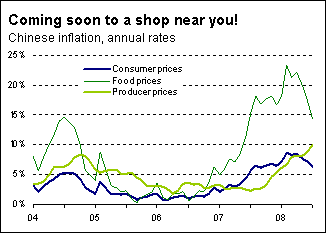"Made in China" gets more expensive
One of the key components of China’s economic development over the last 10-15 years has been the massive scale of production that has been undertaken. Perhaps nowhere are the effects of that epitomised better than in New Zealand’s manufacturing industry. Although other factors such as reduced import tariffs and distance to market have also contributed to the long-term decline in our manufacturing sector, it is clear that businesses in New Zealand are unable to compete with Chinese firms when it comes to large-scale production.
The economies of scale and specialisation enjoyed by the Chinese manufacturing sector are not the only advantages it has over New Zealand industry. Labour costs are also very low. The combined effect of these two factors means that Chinese producers have been able to make products more cheaply than their competitors. By taking away market share from more costly producers, China has effectively been exporting deflation to the rest of the world.
A couple of specific examples should put this in perspective. Since March 1997 (when our exchange rate was roughly the same as it is now), men’s footwear prices in New Zealand have fallen 21%. Over the same period, average incomes have risen 59%. The net result is that shoes are effectively now half the price they were 11 years ago. Some of that change will be due to tariff reductions or increased competition in footwear retailing, but the rise of China is also a significant factor. Sixty-nine percent of imported shoes now come from China, up from 34% in 1997.
Appliances are another example. Back in 1997 I bought a stereo for $970. Four years ago, when looking to buy another one, similar machines sold for under $500. What’s more, the Chinese stereo I ended up buying in 2004 has proven to be significantly more reliable than its Japanese counterpart.

However, China is now at a turning point. After a decade of exporting lower-priced products to the rest of the world, cost pressures are finally starting to bite. The effects of China’s rapid economic growth on global commodity prices are well documented, with the price of everything from steel to cement being pushed up as Chinese demand has continued to expand. Chinese firms are grappling with increased costs and are struggling to manufacture products as cheaply as before. Producer price inflation in China has accelerated from 2.4% to 10%pa over the last year.
It’s not just hard commodity prices that are affecting China’s cost structures. Food price inflation has been rampant over the last 18 months, reflecting both global trends in food prices as well as local factors affecting the price of pork in China. Add in the surge in oil prices, and it is unsurprising that wage demands are on the increase. The rising cost of living is affecting not just poorer people in the rural areas, but the rapidly expanding urbanised Chinese middle class as well.
China will always enjoy production cost advantages due to its size, but its cheap labour is set to become increasingly expensive over the next 20-30 years. Major importers from China are already reporting significant price increases are on their way, which is the opposite of the situation we have enjoyed over the last 10-15 years.
The transformation of the Chinese economy into an economic superpower bears similarities to the advancement of the Japanese economy following World War II. Between 1950 and 1970, Japanese GDP per capita grew by an average of 8.4%pa, compared with 2.3%pa growth for the USA. The rapid lift in incomes, aided by a generous helping of Western-funded investment, saw Japan advance from a developing economy to one of the most developed economies in the world.
If China’s cheap labour is going to gradually disappear, where is the next port of call for manufacturers looking for low-wage staff? Other countries within Asia have varying degrees of potential, with Vietnam, the Philippines, and Indonesia some of the more likely candidates. Over the longer-term, the economic development of these countries throughout Asia will see multinationals shift production into Africa as well. Admittedly, the lack of physical and social infrastructure throughout much of Africa makes this trend difficult to envisage at the moment.
Looking back, we are likely to see that the downward pressure on prices since the early 1990s was unusual. Just as the industrial revolution led to a one-off step down in prices in the late 1800s, China’s own industrial revolution has also led to a structural shift downwards in prices. For consumers, the best is probably behind us, and the "Made in China" label is only going to become more expensive from now on. But as with the Japanese experience, Chinese products are also set to replace their reputation for being cheap with one of high quality and innovativeness.



